Clivia Miniata: features of home care
Clivia Miniata will surely appeal to true connoisseurs of exotic flowers that attract the eye with their colorful colors and unusual buds. An additional advantage of growing this exotic is its relatively unpretentiousness, so you need to remember only a few basic rules for caring for this plant, which you will learn about in this article.
Botanical description of the plant
Clivia (aka Kafra lily) is a representative of a small genus of evergreen herbaceous perennials from the Amaryllis family. You can find them in the natural environment of growth on the territory of the western coast of South Africa, and in indoor floriculture they are grown by flower growers from various countries, in particular the Russian Federation. High decorative qualities are possessed not only by the bell-shaped flowers of the plant, but also by the dense leaves of a deep dark green color, so the plant always looks advantageous, even during dormancy.
Important! The leaves of the described plant secrete a toxic substance, therefore, with any manipulations with the flowerpot, it is necessary to protect the hands with gloves and be sure to wash them after care.
Clivia Miniata (cinnabar or orange) is the most popular variety for home growing, for which there is a logical explanation: large, red-yellow inflorescences that “light” the dark green leaves from February to March. One flower stalk can combine about 20 inflorescences, which only adds splendor to the entire plant. The length of the false stem (formed by fleshy long leaves) is 60–70 cm, and an umbrella peduncle with buds is formed from its very center.


















The main types
Today there are many interesting variations of Clivia Miniata, about the features of which every grower should know.
Learn how to care for clivia at home.
First of all, we are talking about such exotic plants:
- Clivia White - a flower up to 70 cm high, with long and dense leaves of dark green color. About 20 bell-shaped inflorescences of a pure white color are formed on the peduncle. The flowering period of the plant is the beginning of spring.
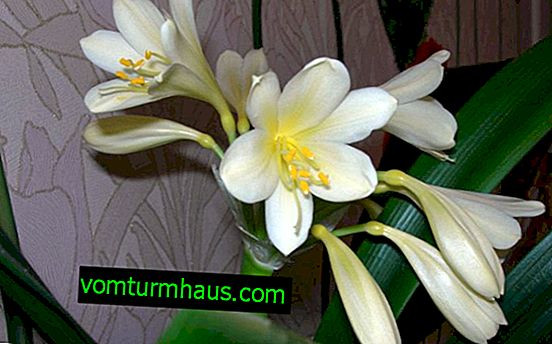
- Clivia Yellow is a variety with large yellow flowers of an umbrella type. They have a very pleasant aroma and bloom on a long peduncle. Yellow clivia reaches the peak of its decorativeness closer to the second half of spring, when all formed buds bloom on it.

- Clivia Noble is one of the oldest varieties, since this plant was discovered back in 1828. The height of the bush is 30 cm, long dark green leaves are xiphoid, slightly narrowed at the end. The peduncle grows up to 50 cm in length and forms about 60 slightly drooping, tubular inflorescences of bright colors (red or yellow-orange). This variety blooms before the rest - in the second half of winter.
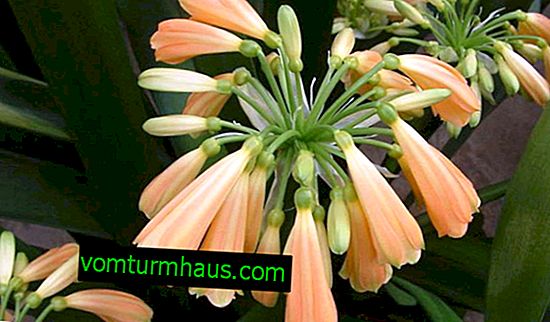
- Clivia Gardena is a species discovered by Robert Gardena, who in 1856 discovered an unusual plant in the city of Quasal (former Natal province, South Africa). The natural habitat of the plant is a foothill shady area at an altitude of about 1300 m above sea level. At home, this Kaffir lily grows up to 50 cm in height and forms bright green, xiphoid leaves up to 90 cm long. Flower buds form at a high peduncle, and after blooming turn into bell-shaped flowers of red-orange color. The plant blooms mainly in the autumn, but sometimes the flowers bloom with the onset of winter.

- Clivia the Beautiful is one of the smallest varieties of this plant, its height does not exceed 28-30 cm. Dark green leaves are of the usual xiphoid shape, with a slightly pointed edge, and on long thick peduncles up to 60 medium tubular-shaped inflorescences and orange color are formed. The beginning of flowering of the plant is observed from mid-January and continues until the beginning of the spring period.
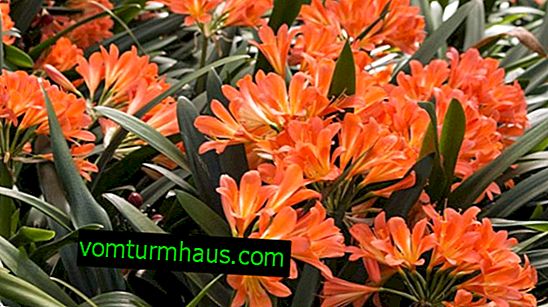
- Clivia Citrina is a species discovered in 1899 and characterized by delicate creamy yellow flowers. With good care, it grows up to 60 cm and pleases not only with a long peduncle with fragrant flowers, but also with long, belt-shaped leaves of a deep green color. The flowering period of the species is from early February to late March.

- Clivia Stable - a variety discovered in 1943 on the territory of South Africa. A distinctive characteristic of the flower is an unusual and high stem, formed from lower dried leaves and having an airy root system. Leaf plates are belt-shaped, dark green in color, smooth to the touch. Inflorescences are drooping, bell-shaped. Medium-sized flowers of red-orange color bloom with the arrival of the first heat or in the summer, in rare cases, flowering is possible in the fall.
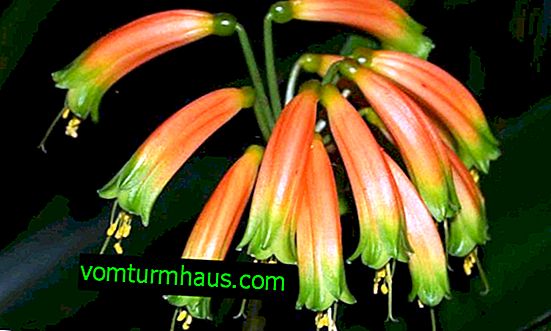
House growing conditions
Choosing Clivia Miniata as a houseplant, it is important to know about some of the rules for its cultivation. Consider the basic requirements for the cultivation of an exotic flower.
Lighting and ventilation
Clivia prefers bright, but at the same time diffused lighting, since prolonged exposure to direct sunlight can be detrimental not only to flowers, but also to leaves of decorative culture. Given this feature, it is worth placing a pot with a plant on the east or northwest windowsill.
Did you know? In 1920, the German astronomer Karl Rainmouth discovered a small asteroid with a diameter of only 7.87 km. The cosmic body was named "(935) Clivia" - in honor of this houseplant. In total, Rhinemouth discovered 395 asteroids.
To shade the culture on particularly hot summer days, you can use blinds or mesh tulle, which will also serve as a small obstacle in case of sharp gusts of wind. The plant reacts to cold air currents by shedding ovaries and a deterioration in the overall appearance, therefore, when ventilating a room with a plant, it is important to exclude any drafts.
Temperature and humidity
In summer, the values comfortable for clivia will be + 22 ... + 26 ° C. In the autumn-winter time, it is desirable to lower these indicators to + 12 ... + 16 ° C, which will provide the flower with optimal conditions for the rest period.

Home Care
Having properly organized the conditions, it's time to think about proper care for clivia, taking into account its needs for moisture, fertilizers, pruning and transplanting.
Watering
Clivia Miniata is a drought-tolerant plant, so watering at home should always be dosed, taking into account the state of the upper soil layer. In this case, a good irrigation liquid is boiled and settled water at room temperature. On average, it is necessary to pour it under the root no more than 1 time in 3-4 days - as a rule, it takes so much time for the substrate to dry well. Excessive overmoistening of an exotic plant threatens with browning of the tips of its leaves, rotting of the rhizome and base of the stem part.
Important! If, as a result of a decrease in the number of waterings in clivia, the tips of the leaf plates began to dry out, you can partially resume hydration, taking care not to flood the plant.
With the beginning of the dormant period (in October-November), the number of irrigations can be reduced even more, and closer to the calendar beginning of winter, it can be completely stopped. Full renewal of the usual irrigation scheme is possible with the appearance of a peduncle no less than 10-15 cm in length. Its formation will also serve as a guide for the planned increase in temperature in the room with clivia. Ignoring these requirements leads to the "solidification" of the buds and the absence of their further growth and development.

Top dressing
Nutrients need clivia Miniata only during the period of active vegetation, beginning with the advent of spring and continuing until the very end of summer. The frequency of top dressing should not exceed 1 time per month, and in the role of nutrients it is desirable to use complex mineral formulations designed to power decorative and flowering crops. For example, the Ideal preparation or a mixture of potassium nitrate, urea and superphosphate, taken in equal amounts, will be a good option for such fertilizer.
We recommend that you find out how to feed indoor plants at home.
Potash dressing will be especially useful during the formation of the peduncle, but the use of a large number of nitrogen-containing compounds in this case is better to avoid, otherwise, with a large number of lush foliage, flowering will not occur. With the beginning of autumn and until spring, Miniatus’s clivia can not be fed.
Pruning
Formative pruning of clivia is not needed, because its leaves already have an attractive appearance. For sanitary purposes, only the removal of yellowed and shriveled leaf plates is performed, as well as cutting off the faded peduncle (with a sharp knife at the very base). True, if the florist wants to collect seeds for further propagation of the plant, it is worth preserving the peduncle until they ripen. To preserve the decorativeness, you can also trim the yellowed tips of the leaves.

Transfer
A clivia transplant is performed in 2 cases:
- when the roots began to crawl out of the drainage holes;
- with partial decay of the rhizome - of course, if the plant can still be saved by the removal of damaged roots.
A planned transplant of young plants should be performed every year, but adult plants are transplanted less often: about 1 time in 3-4 years. In either case, the pot needs to be changed only at the end of the blooming of Miniatia clivia, having previously prepared a new planting container and a suitable nutrient substrate (for example, a mixture of turf, peat and humus soil in a ratio of 2: 1: 1). The selected pot should be about 3 cm wider than the previous one so that the plant does not feel too loose and retains flowers longer.
Did you know? In the birthplace of Clivia Miniata - in South Africa - local tribes use its leaves to eliminate fever attacks, accelerate labor activity in women, and even to neutralize snake venom.
If you use too large a capacity, flowering will not occur until the rhizome grows throughout the space. Another mandatory criterion for choosing such a tank is the presence of drainage holes that provide sufficient air exchange and prevent possible decay of the root system of the plant due to stagnation of moisture.

- Place a layer of 2 cm expanded clay or any other material at the bottom of the new pot to create drainage.
- Pour the ready-made nutrient mixture for flowering plants or a self-prepared substrate (should reach the middle of the pot).
- Carefully remove the plant from the previous container, trying not to break the roots (if this happens, immediately sprinkle the broken place with crushed charcoal).
- Place clivia in a new pot and slowly cover it with prepared substrate, slightly compacting it.
- Water the plant and leave it in a shaded and warm enough place, and after a few days transfer it to the usual windowsill.
If a transplant is not necessary, but the nutritional value of the soil in the pot is in doubt, you can replace only 5 cm of the upper layer of the substrate using a new slightly acidic soil. If possible, it will be useful to add 2 tablespoons of slowly acting phosphate fertilizers for every 3 liters of land.
Rest period
The "winter hibernation" of clivia (especially young specimens) should last at least 2 months, starting in mid-autumn. However, the larger and older the plant, the longer the dormant period will be, and in this case, it is worthwhile to stop watering a little in September. Almost the entire winter season, the flower should rest, contribute to what you can, simply taking the pot with it to a cooler room with a temperature of at least + 12 ° C.

Breeding
When growing exotic Kaffir lily, the optimal methods for its propagation are to separate the children and sow the seeds. True, with regard to the latter option, it will require more time and effort. Let's consider each of them in more detail.
Read more about how it propagates: orchid, azalea, anthurium, spathiphyllum and cyclamen.
Kids
The vegetative method of reproduction is always much simpler than the generative one, therefore clivia propagation by separating the shoots is even possible for beginner growers. All that is required is to separate from the specimen that has faded this year the required number of lateral processes on which at least 4 own leaflets have already been formed, and plant them in separate pots of sand with a diameter of about 7 cm.

Seeds
The seed method of propagating an exotic culture is somewhat more complicated than a vegetative one, especially if you decide to harvest planting material yourself from an existing plant. When growing Clivia Miniata at home, it will have to be pollinated artificially, transferring pollen with a brush. To simplify the task, buying ready-made seeds in a horticultural store will help, after which it remains only to soak them for a day in water, and then sow them in a mixture of peat and perlite, combined in equal proportions. Seeding depth should not exceed 1 cm, and between adjacent seeds it is desirable to maintain a space of 2 cm.
Important! From about the 4th year after the planting of clivia seedlings, Miniat should arrange dormant periods (from September to November), reducing the frequency of watering and moving the pots to cooler places.
The filled planting container must be covered with glass or plastic film and left indoors at a temperature of + 20 ... + 25 ° C, moistening and airing the seedlings as necessary. The appearance of the first sprouts can be expected in 1–1.5 months, and as soon as the first leaves form on them, seedlings should be dived into separate pots filled with a mixture of clay soil, humus and leaf soil.

Possible growing difficulties
All the difficulties in growing an exotic African flower are due to a violation of the rules of care, as a result of which the plant may suffer from pests or the development of pathogens. In both cases, it is important to know about the possible symptoms of such troubles and how to solve each specific problem.
Disease
Almost all varieties of clivia are characterized by good immunity to the main diseases of indoor flowers, but a violation of the rules of care and possible pest damage worsen the appearance of the plant, contributing to the development of certain ailments.
Important! In case of any disease of clivia , just in case, it is better to temporarily remove it in the quarantine zone, which will prevent possible problems with other decorative cultures.
The most common of them include:
- Fungal disease stagonosporosis, characterized by the appearance of red spots on the rhizome of the flower (if you carefully remove clivia from the ground, it is easy to notice diseased roots that differ from healthy ones in brown). With partial damage to the root system, carefully remove the diseased roots and transplant the flower into a smaller pot. If more than half of the rhizome is affected, then it is most reasonable to plant a new plant, and the old will have to be discarded.
- Red burn is another ailment of fungal origin, the reasons for the development of which are often excessive waterlogging of the soil and low temperature in a room with a pot. To eliminate the problem, it is necessary to completely remove the affected parts (mainly leaves) to the very base. If signs of the development of the disease appeared on the roots, then some of their parts will have to be cut off. To prevent further spread of the problem, the remaining roots are soaked in fungicidal solutions (for example, the Ordan preparation) and, after thorough drying, they are planted in smaller containers filled with a sand mixture.

- Root rot caused by the activity of pathogens living in the soil. In this case, clivia will have to be transplanted into a new substrate, previously steamed or spilled with a weak solution of potassium permanganate.
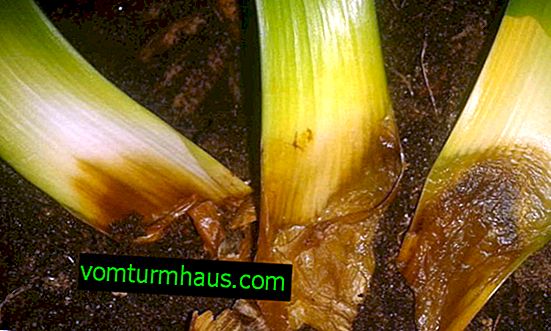
- Leaf spotting and drying . Иногда эту проблему ошибочно принимают за признаки конкретного заболевания, но чаще всего такое явление связано с прямым воздействий солнечных лучей, которые и оставляют на растении ожоги. Попробуйте перенести горшок в другое место или просто почаще заслоняйте окно шторами.
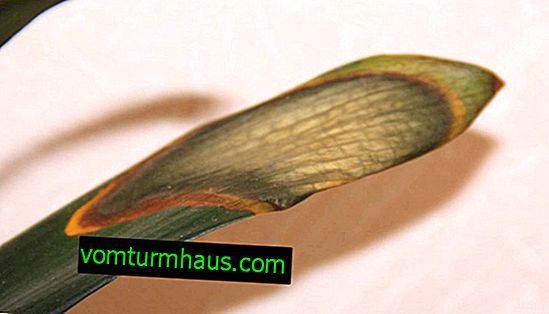
Иногда кливия Миниата по непонятным причинам перестаёт цвести.
Вам будет интересно узнать почему не цветёт кливия и как заставить её цвести.
Оснований для этого, как правило, несколько:
- естественные изменения, связанные с периодом зимовки,
- нарушение правил ухода во время периода покоя (например, переувлажнение субстрата или перекорм растений питательными веществами),
- чрезмерное количество азотсодержащих подкормок, которые способствуют разрастанию зелёной массы, но при этом снижают интенсивность цветения.
Также стоит не забывать проверять температурные показатели — возможно, цветку просто очень жарко в комнате.
Pests
Самыми частыми вредителями кливии заслужено считаются мучнистые червецы, тля и щитовки, оставляющие на листовых пластинах небольшие коричневые пятна, которые и указывают на конкретные места высасывания питательных веществ. Признаком поражения растения мучнистыми червецами выступает деформация листовых пластин, стрелок и цветков вазона, ну а тля оставляет на всех частях растения липкие следы и множество миниатюрных проколов, которые можно заметить при внимательном рассмотрении растения.

Learn how to plant indoor flowers in a pot.
В целом же, несмотря на редкие возможные трудности, кливию Миниата действительно можно считать одним из самых интересных и экзотических растений для выращивания в комнатных условиях. Яркие цветы и пышная зелёная листва станут украшением любого интерьера, регулярно привлекая взгляд не только гостей, но и самих обитателей дома.













